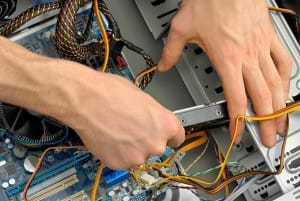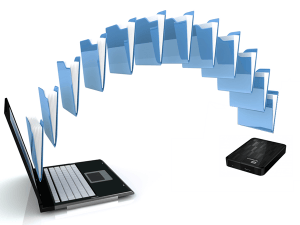Replace my 2nd hard drive
 Replace my 2nd hard drive: a reader asks…
Replace my 2nd hard drive: a reader asks…
Hi Chris, My boot drive (C:) is an SSD that has Windows 8.1 and a few other programs but most of my programs (and lots of data) are on my D: drive. I recently ran chkdsk d: /f /x /r which ran for hours and found and corrected many, many errors. Seeing the handwriting on the wall, I am now backing up the entire drive (using Acronis) to another drive while I still have time. So here’s the question: if I buy a new drive to replace the old one and restore it from Acronis, can I simply call it the D: drive and have all the programs correctly linked? I am under the assumption that it is NOT a good idea to clone a drive with bad sectors and that Acronis is not cloning. Is that true? Another related question: I have been maintaining a backup of D: drive using the Windows (8.1) backup, but that only backs up data in the libraries, not the programs. Could I put programs and everything into libraries and use the Windows backup instead of Acronis? I should add that I’m not in a desperate situation because I have my important data files synced to Dropbox. My main concern is the programs; I don’t want to have to reinstall them all unless I really need to. Thanks!
It sounds like you’re pretty comfortable working with hardware and software, so let me give you a few tips first directly related to your questions. I’m assuming you’re using Acronis True Image or Disk Director:
 Do all the programs correctly link? Yes, since you have programs installed on a secondary hard drive, Microsoft Windows just uses the drive letter and folder naming structure for program linkages. However, if you have program files that were corrupted, they will not magically show up on the new D: drive uncorrupted. When in doubt, reinstall the programs.
Do all the programs correctly link? Yes, since you have programs installed on a secondary hard drive, Microsoft Windows just uses the drive letter and folder naming structure for program linkages. However, if you have program files that were corrupted, they will not magically show up on the new D: drive uncorrupted. When in doubt, reinstall the programs.- Does Acronis clone the disk and is cloning a bad idea when you have a failing hard drive? No matter which process you use to copy files from a failing drive to another, corrupted files will botch up the process, so it’s neither a good or bad idea. Acronis clones when you choose the cloning option, and migrates when you choose the migrate option. In both cases, it can be told (via a checkbox) to skip bad files. Since you’re replacing a secondary drive, much of the complexity of the process isn’t applicable, so either method will work. Again, if you have corrupted program files they will not be fixed on the replacement hard drive – for that you have to reinstall the program.
- Can I put programs into my libraries so Windows Backup will backup the programs? While possible, this is not really the best way to go about this. You’d have to do what you don’t want to do, re-install all the programs so you can specify the installation location. Just moving the program directories over to a library isn’t enough, there are tons of shortcuts and registry entries that would have to be revised as well.
Ok, now let’s take what you want, boil it down and get a good process for you to use: The simplest method with the least amount of work for you is to use the reliable Acronis to migrate (or clone) your failing D: drive to the replacement. Be sure to check the box to skip bad files. Then swap the hardware so your new hard drive is the designated D: drive. Once that’s done, run each program that you have installed on the D: drive. If the program runs and works ok, great! If it crashes, refuses to run, or has problems, reinstall the program. As for your personal files, you’ll probably want to restore the libraries from your Windows Backup, if there were any corrupted files they won’t have been copied over so you might have some missing files.
Alternatively, you could do this manually instead of using Acronis. While I like automatic tools, it’s easy for something to go wrong. And if/when it does, these programs arent’ great about telling me exactly what’s wrong. Again because it’s a secondary hard drive, it’s a lot simpler than if you were replacing your primary/boot drive. But since Windows stops a manual copy anytime it runs across a corrupted file, you should do the copying over in small batches of folders at a time. That way you can get a good idea of which folders have corrupted files. Here’s the manual steps:
 First, make sure that your Windows Explorer is set to show hidden and system files temporarily so you don’t miss any files.
First, make sure that your Windows Explorer is set to show hidden and system files temporarily so you don’t miss any files.
Second, connect an external hard drive to your computer, and start copying small groups of folders from the D: drive to the external drive. Anytime you get an error, stop and re-copy individual folders till you get one that fails. That tells you which folder contains one or more corrupted files. Keep going till you’ve gotten all the folders on the D: drive copied (that don’t error out). You should end up with a list of folders with bad files.
Third, replace the D: drive with a new hard drive, and make sure that the new drive is initialized and formatted as D:.
Fourth, re-connect that external hard drive and copy back everything from the second step back onto the D: drive.
Fifth, using your list of folders with bad files, reinstall any programs that had bad folders listed. Now go to your Windows backup and restore any folders that are on that list.
I admit the simple way will probably go a lot faster for you, so you should start with that. Feel free to let me know how it goes in the comments below, thanks!
This website runs on a patronage model. If you find my answers of value, please consider supporting me by sending any dollar amount via:
or by mailing a check/cash to PosiTek.net LLC 1934 Old Gallows Road, Suite 350, Tysons Corner VA 22182. I am not a non-profit, but your support helps me to continue delivering advice and consumer technology support to the public. Thanks!
 Do all the programs correctly link? Yes, since you have programs installed on a secondary hard drive, Microsoft Windows just uses the drive letter and folder naming structure for program linkages. However, if you have program files that were corrupted, they will not magically show up on the new D: drive uncorrupted. When in doubt, reinstall the programs.
Do all the programs correctly link? Yes, since you have programs installed on a secondary hard drive, Microsoft Windows just uses the drive letter and folder naming structure for program linkages. However, if you have program files that were corrupted, they will not magically show up on the new D: drive uncorrupted. When in doubt, reinstall the programs.






Hi Chris,
I followed your advice and copied all the files on my failing D: drive to another internal drive. To get the space, I deleted the Acronis D: drive backup files. To reduce the amount of data I also deleted programs that I never use, cleared local content of some infrequently played Steam games (very big files), and looked around for larger files that I no longer need (more of them than I realized!). The deletion created some system hangs as did the copying, which indicated that they were damaged files. When it was all done, I used Disk Management to renamed the target drive to D: and the bad drive to Q: and everything worked perfectly. After checking out a few programs and files, I then removed the old, failing drive and tossed it in the trash. It was interesting that my startup was measurably faster once I removed the old drive completely. Even after I renamed it and wasn’t using it for anything, I think that Windows was trying to deal with the problems. Am I right about that? Next step is to move more programs to the faster C: drive.
In the future, I think it will be best if I just use Acronis to backup my C: drive and use a combination of Dropbox and periodic copying to backup the data drive.
Thanks for your excellent assistance on this!
Cheers!
Ed
I’m happy to help!
I wouldn’t just toss the hard drive in the trash. First off, it still contains your personal data files. Even if you reformatted the hard drive or deleted the partition, it’s still relatively easy for a hacker to reconstruct the data on it. It’s also recyclable. The best solution is to take it to a security recycler, such as http://www.proshred.com (they have an office in Sterling VA). If you take it to them it costs like $6-10 and they physically destroy the hard drive so nobody can get the bits and bytes from it.
Malfunctioning hard drives do drive Windows a little crazy, so it’s always going to speed things up when they’re removed. Yay!
I think uninstalling the programs from the D drive and reinstalling them on the SSD C drive is a good move, that will help make programs load a lot quicker.